Key takeaways:
- Understanding children’s emotions involves recognizing non-verbal cues and expressing feelings through creative outlets like art and storytelling.
- Emotional expression is vital for children’s development, enhancing communication skills, emotional regulation, resilience, and stronger relationships.
- Effective techniques to encourage emotional expression include active listening, using “I feel” statements, and emotion charts.
- Creating a safe environment for emotional sharing involves building trust, setting clear boundaries, and establishing rituals like feelings check-ins.
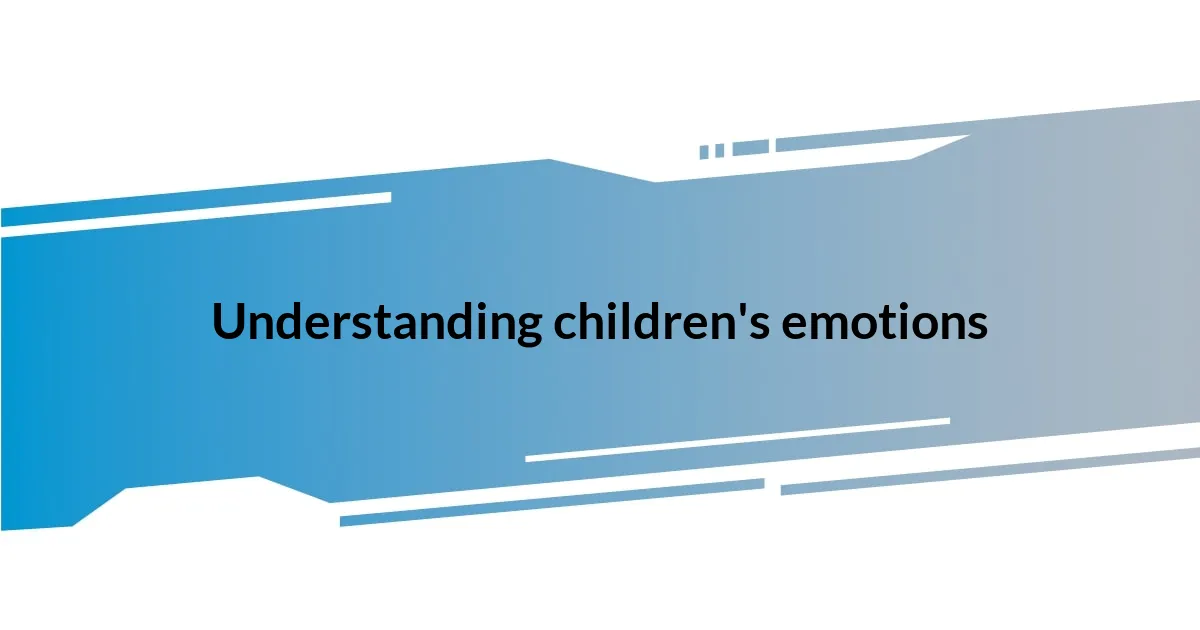
Understanding children’s emotions
Understanding children’s emotions is like peering into a kaleidoscope; each shift reveals a new color and shape. I remember once sitting on the floor with my daughter, who was just four at the time, feeling frustrated because her favorite toy was missing. Her little face crumpled as tears streamed down, and I realized that in that moment, it wasn’t just about the toy—it was an expression of feeling lost and anxious. Have you ever noticed how children will often react to emotions in ways that seem puzzling?
Emotions can be incredibly complex, even for young children who don’t have the vocabulary to express what they feel. I’ve found that sometimes, my son would act out at school, his energy bursting to the surface. In those instances, I later learned he was feeling overwhelmed—a mix of excitement and fear about a new experience. I often wonder how many children are facing similar internal battles, unable to communicate their feelings, which leads to misunderstood behaviors.
Children may not always articulate their emotions clearly, but their actions often speak volumes. One evening, after a tough day at school, my daughter began doodling with bold strokes on a piece of paper. In that moment, I recognized that drawing was her way of pouring out the feelings she couldn’t express in words. It made me think: how often do we overlook the non-verbal cues that unveil the emotional world of our children? By paying attention, we can help them navigate their emotions more effectively.
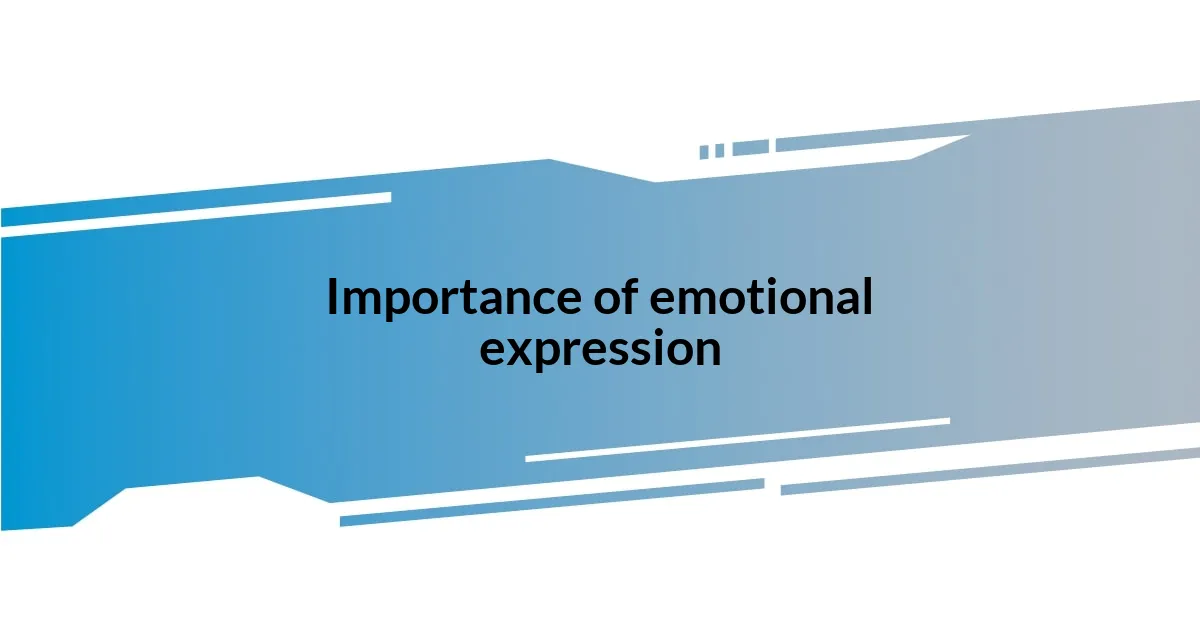
Importance of emotional expression
Emotional expression is crucial for children’s development, as it helps them process and understand their feelings. I recall a time when my son tried to express his frustration during a soccer game. Instead of using words, he kicked the ground in anger. It struck me then that providing him with tools to verbalize his feelings could transform those moments of frustration into healthy conversations. Children who express emotions tend to develop stronger relationships with peers and adults, fostering empathy and compassion.
Here are some key reasons why emotional expression is so important for children:
- Improved Communication Skills: When children articulate their feelings, they enhance their language skills and learn to express needs clearly.
- Emotional Regulation: Venting emotions in a safe environment helps children learn how to manage feelings and behaviors effectively.
- Resilience: Understanding and expressing emotions can build a child’s resilience, equipping them to handle life’s challenges better.
- Stronger Relationships: Children who communicate their feelings form deeper connections with friends and family, paving the way for supportive relationships.
By nurturing their ability to express emotions, we empower our kids to navigate the world more confidently.
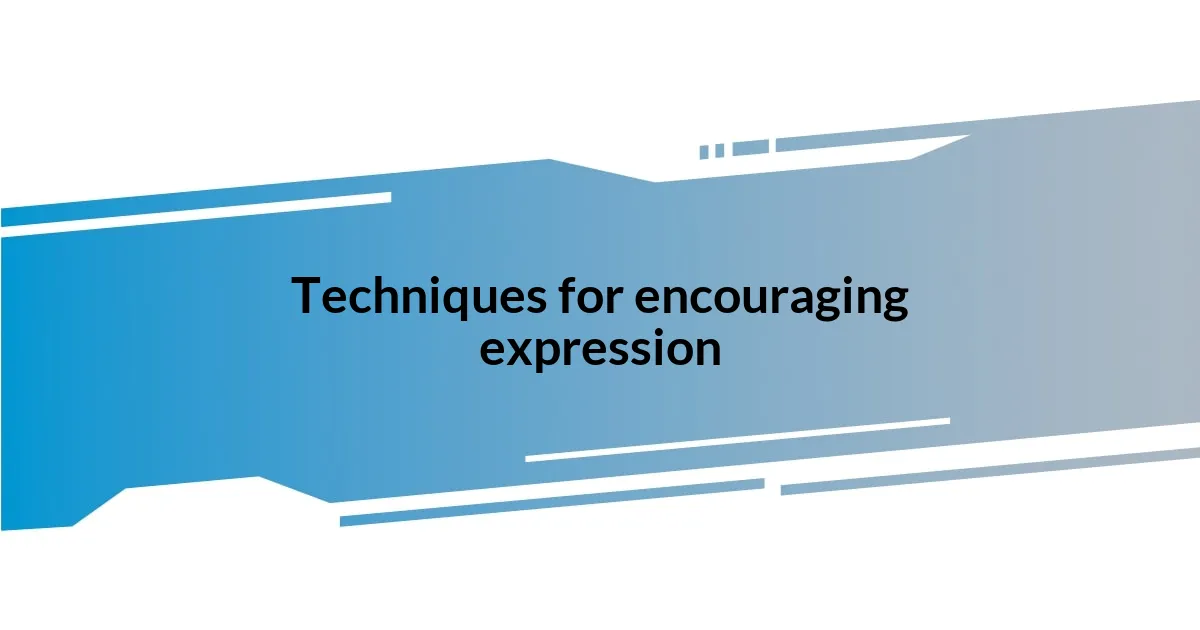
Techniques for encouraging expression
Techniques that foster emotional expression can vary widely and may depend on a child’s personality. One of my go-to methods is introducing art as a means of communication. I remember my younger daughter, who was always more reserved, blossoming when we started painting together. She would choose colors that reflected her mood, and I could then ask her about the story behind each piece. It was like unlocking a treasure chest of feelings she had tucked away. Have you ever noticed how color can evoke emotion? Art expands the conversation, creating a rich tapestry of dialogue about emotions without the pressure of verbal articulation.
Another effective technique I’ve discovered is utilizing storytelling. I often gather my kids for storytime, reading books that touch on various emotions. After reading, I encourage them to share their own stories or feelings related to the narrative. Once, I read a book about a little bear who felt shy. Afterward, my son opened up about feeling shy during his first school dance. Sharing stories allowed him to see that his emotions were valid and common, which he found incredibly comforting. It creates a safe space for discussion, doesn’t it?
Lastly, role-playing has been a powerful tool in our household. I recall one afternoon when we acted out different scenarios—like losing a toy or feeling left out at the playground. My son, who often found it hard to articulate disappointment, surprisingly thrived in these moments. When he stepped into a character’s shoes, he verbalized emotions I hadn’t heard from him before. It was fascinating to observe how acting out these situations allowed him to confront feelings in a playful way, ultimately enriching his emotional vocabulary.
| Technique | Description |
|---|---|
| Art | Using creative activities to facilitate the expression of emotions and encourage dialogue. |
| Storytelling | Reading stories that address feelings, followed by discussions to relate them to personal experiences. |
| Role-playing | Engaging in interactive scenarios that allow children to express and explore their emotions through characters. |
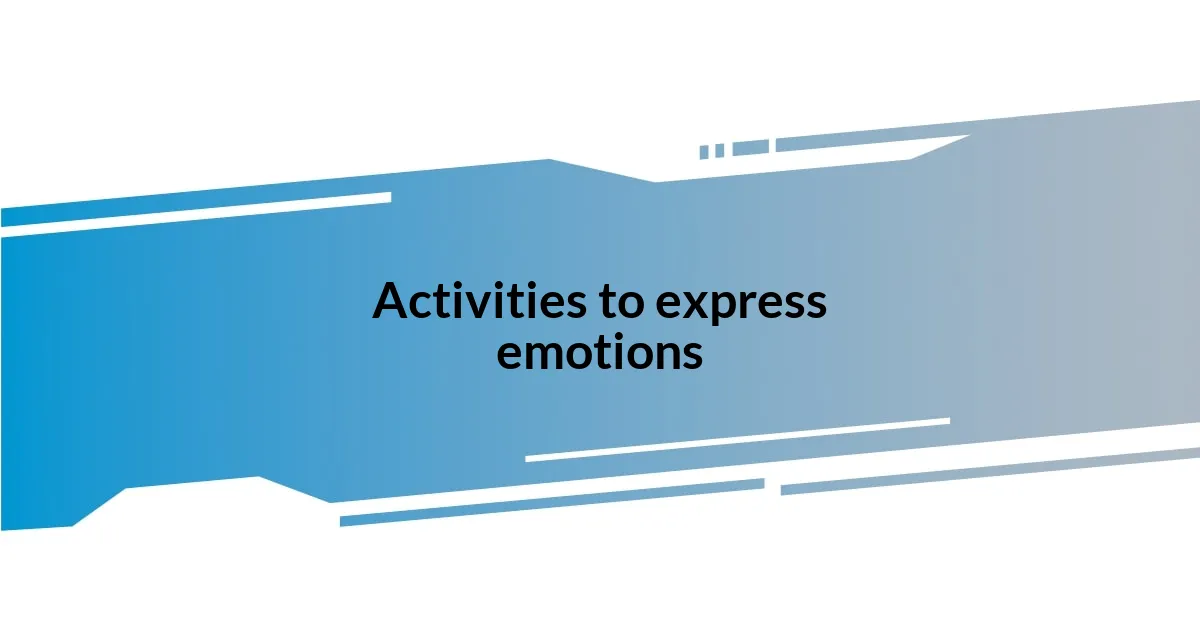
Activities to express emotions
One activity that has truly transformed how my kids express their emotions is creating a feelings jar. We started this simple yet profound practice during a particularly challenging week for my daughter, who seemed overwhelmed with school and friendships. Each evening, we would sit together, and she’d pick a color-coded slip of paper that represented her emotions—from happy to sad. As she described her day, it was remarkable to watch her gradually articulate feelings she didn’t even realize she was holding onto. Have you ever noticed how naming emotions can lighten their weight?
Another engaging activity I’ve found effective is writing letters to emotions. Whenever my son is feeling angry or anxious, I encourage him to write a letter addressing that emotion. For instance, he once wrote a humorous yet insightful letter to “Anger,” detailing how it felt in his body and what might help it feel better. This not only provided him an outlet but also sparked a unique conversation about how emotions can be both uncomfortable and understandable. Hasn’t everyone wished they could send a letter to their feelings sometimes?
In our home, music has also played a pivotal role in encouraging emotional expression. After a long day, we often have ‘jam sessions’ where we listen to songs that resonate with our moods. One evening, my son sang along to a song about feeling lost, and it surprised me to see him visibly process his own feelings of uncertainty about a new school year. Music creates a bridge between emotions and expression, doesn’t it? It allows children to resonate with what they feel and, in turn, share those emotions with clarity. The rhythm of the beat seems to give them permission to dance through their feelings.
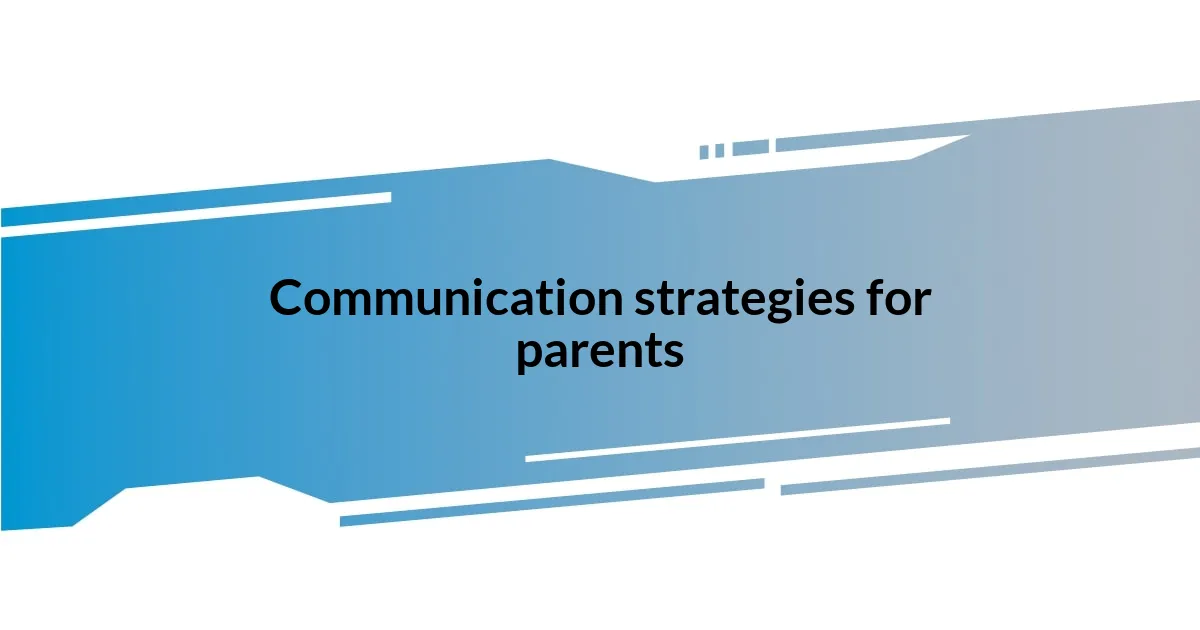
Communication strategies for parents
One strategy that has worked wonders for us is practicing active listening. I remember a moment when my daughter came to me, distressed about a friend who had been unkind. Instead of jumping in with solutions, I focused completely on her, reflecting back her feelings and validating her experience. It felt as if the mere act of listening without judgment opened up a pathway for her to express much deeper feelings than I anticipated. Have you ever realized how just being present can help a child clarify their emotions?
Another approach I’ve found helpful is using “I feel” statements during discussions. You know, children often need a little guidance when it comes to articulating emotions. When my son was upset after being excluded from a game, I gently prompted him, “I feel upset when…” This not only helped him express his emotions more clearly, but it also modeled emotional articulation for him. It’s fascinating how starting with “I” empowers children to own their feelings, isn’t it?
Lastly, I encourage the use of emotion charts at home. I placed a colorful chart on the fridge, with various facial expressions corresponding to different feelings. We’ve made it a fun tradition to check in with each other throughout the day. One afternoon, my son pointed to the “frustrated” face while working on his homework and told me exactly why he felt that way. It’s moments like these that remind me how visual aids can spark conversations and help children express what they might otherwise keep inside. Have you tried using visuals in your household? They can really make a difference!

Handling difficult emotions
One of the most challenging aspects of navigating difficult emotions is the sheer intensity they can bring. I still remember when my daughter experienced her first bout of anxiety over a school presentation. I sat beside her, encouraging her to describe her feelings as if they were characters in a story. It was eye-opening for both of us; she said her anxiety felt like a “heavy rock” sitting in her stomach. By giving her those feelings a form, it became easier for her to process them rather than feeling overwhelmed. Isn’t it remarkable how giving emotions a voice can ease their grip on our kids?
Moreover, I’ve found that physical activity can be a powerful tool for managing tough emotions. I encourage my son to channel his frustrations through movement, whether it’s jumping on the trampoline or a quick run around the yard. One evening, after a particularly grueling day at school, he threw a makeshift dance party in the living room. As he twirled and leaped to his favorite songs, it became evident that his energy was shifting—from pent-up frustration to pure joy. Doesn’t movement have a unique way of transforming feelings, almost like releasing a pressure valve?
Lastly, I think it’s vital to normalize the experience of difficult emotions. In our household, we openly discuss how everyone, including adults, has their tough days. I vividly remember a time when I broke down after a long week at work, and my kids rushed to comfort me, reminding me that it’s okay to cry. By showing them that everyone has emotions, I’m inviting them into a safe space where expressing those feelings is not just accepted but cherished. How can we teach our kids to be authentic and resilient if we don’t model that ourselves?

Creating a safe environment
Creating a safe environment for children to express their emotions starts with establishing trust. I recall a rainy Saturday spent building a fort in our living room. As the walls of blankets surrounded us, my kids shared their fears about starting school the next week. The coziness of our little hideaway made it easier for them to voice their worries. Isn’t it incredible how the simple act of creating a comfortable space can encourage open dialogue?
Another important aspect is setting clear emotional boundaries. One day, during a family dinner, my son was frustrated after losing a game and started shouting. Instead of reprimanding him, I calmly explained that we could discuss those feelings without raising our voices. It’s amazing how setting these boundaries helped him feel secure enough to express himself without fear of reaction. How often do we reflect on our own responses when our kids are upset?
Finally, I incorporate rituals that foster emotional sharing. For instance, we hold “feelings check-ins” before bedtime. Each family member takes a turn sharing how their day felt—like a mini-debriefing under the stars. One night, my daughter surprised us by saying she felt “invisible” at school. It opened up a genuine conversation about empathy and connection. Doesn’t it just warm your heart when kids feel safe enough to share their depths with you?